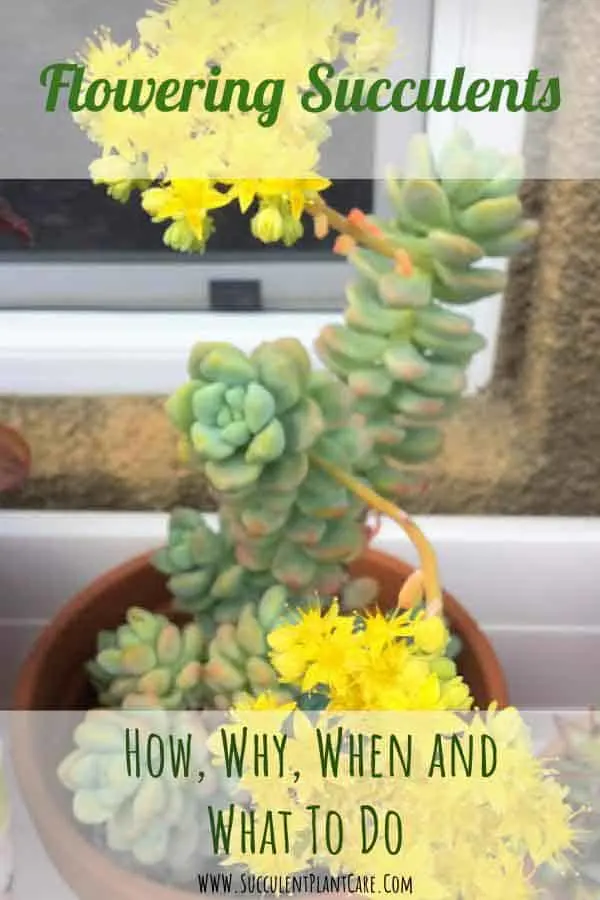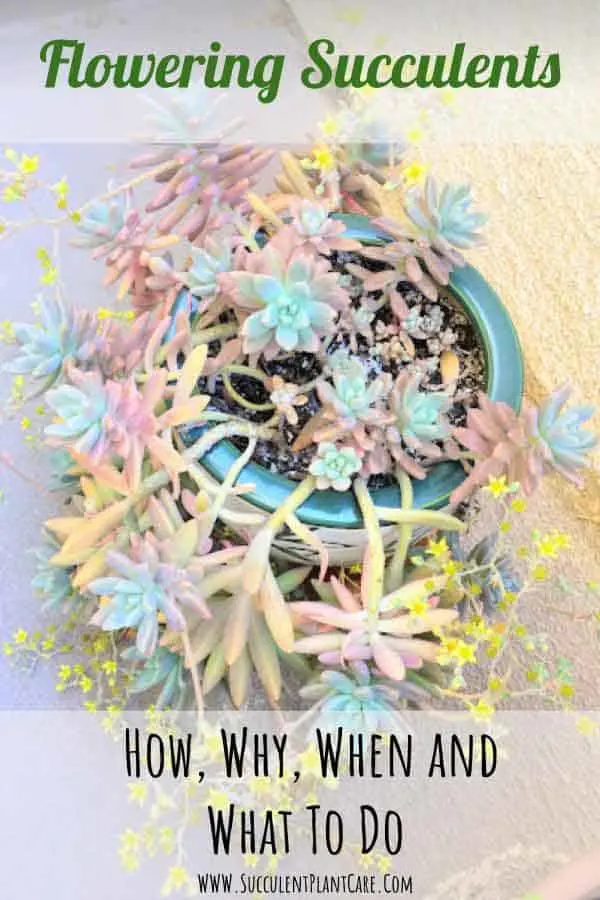I get a lot of satisfaction from seeing my succulents bloom. To me, it’s a validation that they are happy and doing well. But not all succulents bloom and some may never bloom at all.
Is blooming necessary? What does it mean when succulents flower or bloom? Should you expect your succulents to flower? What do you do when it does? What do you do with the bloom stalks after?
These are some of the common questions people have about flowering succulents. You will find the answers to these questions and many more right here.

Why Do Succulents Flower?
Like all other plants, succulents flower to attract pollinators. It is nature’s way of surviving and ensuring the production of the next generation. And how do they do this?
By producing seeds within the flowers. Flowers contain reproductive parts of the plant. Flowers are brightly colored and sweetly scented to attract pollinators like bees, butterflies and birds.
In the wild, succulents rely on insects and other animals for pollination to reproduce. In cultivation, flowers can also be self-pollinated using a paintbrush to pollinate the flowers. The goal is the same–seed production. The seeds can then be harvested and germinated to produce new plants.
Plenty of succulent and cacti growers reproduce their plants this way, through seed collection. However, there are other ways to reproduce succulents such as leaf or stem propagation so harvesting the seeds is not a requirement in order to multiply succulents.
Read more about succulent propagation in this article “4 Easy Ways to Propagate Succulents: A Step-by-Step Guide”.
Do Succulents Die After Flowering?
Fortunately, most succulent plants do not die after flowering, although some do. Monocarpic plants are plants that die after they flower. The plant dies after it’s done blooming which is why it is also called the bloom of death.
Some monocarpic succulents are: Sempervivums (Hens and Chicks), most Aeoniums and most Agave plants. One way to tell if the plant is monocarpic is by the way the plant flowers. If the flower comes out from the center of the plant and the whole plant seems to transform into a bloom stalk, it usually is monocarpic. Otherwise the bloom usually comes from the sides of the plant.
There really isn’t anything you can do once you see a monocarpic plant flowering. You cannot stop the process so you may as well enjoy it. While it may sound tragic, monocarpic plants do not die in vain.
Most monocarpic succulents are great producers, meaning they would have produced plenty of pups or baby plants before they flower and die. The pups and baby plants will continue living, only the mother plant dies after flowering.
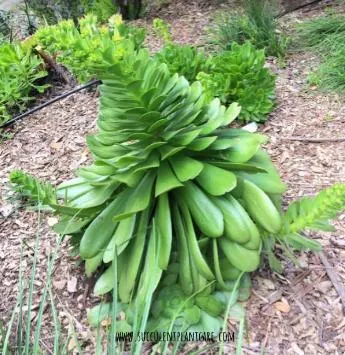
Pictures of monocarpic plants
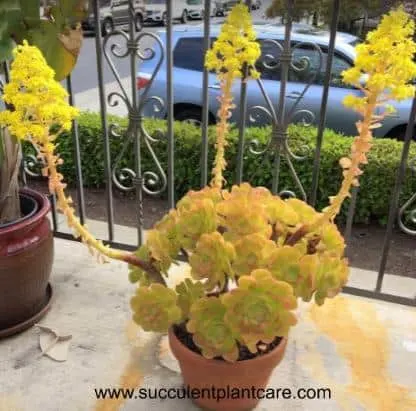
Do All Succulents Flower?
No. Not all succulent plants flower. Some may take years before they are ready to bloom and some may not flower at all. Some succulent species flower freely even when young whereas other species need a maturation period before they are ready to flower.
A lot also depends on environmental factors and growing conditions. There are things you can do to encourage blooms such as providing the right temperatures, plenty of sunlight, and an environment that mimics their natural habitat.
How To Get Succulents To Bloom
A happy and healthy plant will have a greater chance at blooming than a struggling one so it is important to provide the proper growing environment for the plant to grow and thrive. Succulents and cacti need adequate sunlight in order to bloom. Provide at least 5-6 hours of sunlight a day to keep the plants happy.
Provide the plant with a well draining soil. Succulents do not like to sit in wet soil so it is important to provide the proper soil medium to keep them happy. A cactus mix combined with perlite is a good way to start.
Combine the two materials in a 2:1 (cactus mix:perlite) solution. You may also add coarse sand to the mixture to provide more drainage. Find out more about soil and soil amendments in this post “Best Soil and Fertilizer for Succulents”.
Here are some of my soil and soil amendments recommendations.
Along with the proper soil mixture, you also need to pay attention to watering techniques. While it is important to provide adequate water, too much water can be detrimental to succulents. Allow the plant to dry in between watering. As a rule of thumb, the top inch of the soil needs to be dry before watering again.
Read more about watering succulents here: “How and When to Water Succulents”.
To find out more about how you can encourage your succulents to bloom, visit my post on “How To Get Succulents and Cacti To Bloom”.
When Do Succulents Bloom?
Succulents bloom at different times of the year. Some bloom in early spring to late summer, but some can also bloom in the fall and winter months. It depends on the type of succulents you have and the environmental conditions they face.
How Do You Care For a Flowering Succulent?
You do not need to give a flowering succulent any special treatment. A flowering succulent is meeting all of its needs just as it is. Just continue to provide the same care you’ve normally been giving your plant and it will do the rest.
Some people like to supply extra nutrients to the plant to ensure that it is receiving the proper nutrients it needs for growth and to sustain the blooms. Fertilizer administered at ¼ to ½ strength every two to four weeks should be sufficient and will supply your plants the nutrients it needs. Here are some of my fertilizer recommendations.
The only time I’ve seen my succulents fail to fully bloom or achieve a full bloom is when they have been overwatered. This is when a succulent plant or a cactus starts shooting out what appears to be a bloom stalk but then fails to fully bloom. I’ve seen this on overwatered plants and plants that have stayed wet from too much rain outdoors. If you want to see your succulents bloom, particularly cacti, it is important to provide enough water but not to overwater.
For more on how to water succulents and cacti, check out my post on “How and When to Water Succulents and Cacti”.
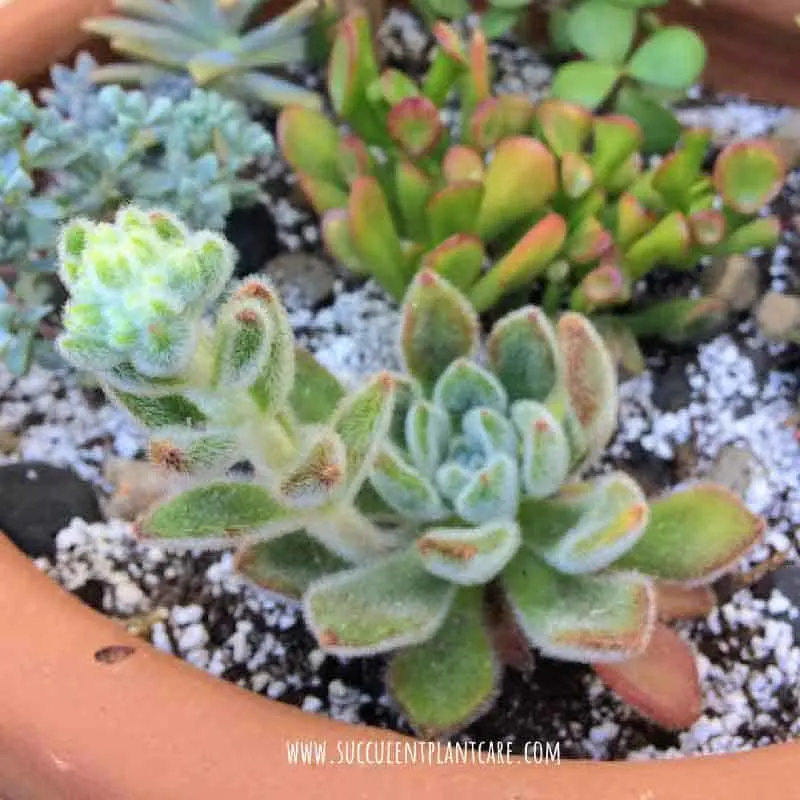

Can You Plant Succulent Flowers?
No. Succulent flowers will not grow into new succulent plants. What can grow into new flowers are the seeds that the flowers contain. The flowers need to be pollinated either by pollinators or by self-pollination to produce the seeds that you need to grow into new plants.
These seeds will need to be harvested, germinated and planted to form new plants. Simply planting the flowers alone will not do the job of reproduction.
What you can do instead of planting the succulent flowers is propagating the succulent stems and leaves. Most succulents propagate easily from leaf and stem cuttings. It is easy enough to multiply your succulent collection through propagation.
Read more about succulent propagation in this article “4 Easy Ways to Propagate Succulents: A Step-by-Step Guide”.
Should You Cut The Flowers Off Succulents?
It takes a certain amount of energy for succulents to bloom and to maintain the bloom. Some people are not impressed by the flowers succulents produce and prefer to cut off the bloom stalks in order to redirect the energy back to the plant where it can refocus its energy on growing. I personally love to see blooms from my succulents no matter how small or inconspicuous they may seem.
I find all types of flowers beautiful and amazing. Some flowers are tiny and low-key while some flowers are spectacular. Others give a sweet scent and some are foul smelling. I welcome and love them all.
It’s a personal choice when to cut off the bloom stalks. I usually wait until the plant is done blooming and the flowers have dried up before I cut them off. Some people prefer to cut them off before they become unattractive.
What To Do After Succulents Bloom?
Depending on the type of succulent plant, the flowers usually stay in bloom for weeks or even months before the blooms start to close and dry up. You can leave the bloom stalks alone but they really start to look unattractive as they continue to dry up. It is best to cut off the bloom stalks once the plant is done blooming.
Use sharp pruning shears or scissors and cut the blooms stalks off as close to the plant as possible without damaging its leaves. Once you trim off the bloom stalks, you can continue caring for your plant as is. After a succulent plant blooms for the first time, it will usually continue to bloom around the same time every year after that.
To read more about what to do with the bloom stalks, click on “How To Behead an Echeveria and Cut Off Bloom Stalks”.
While getting succulents to flower is not a priority when growing succulents, it sure is a treat to see a happy bloom from them. Keep doing what you’re doing and keep your plants as happy as possible and they will reward you with blooms one of these days.
Wondering where you can find some of these succulents? Click on my resource page for recommendations on where to purchase succulents online.
Pin this to save for later or share with others now!
